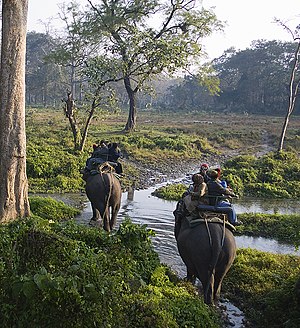
An elephant safari in the
Jaldapara Wildlife Sanctuary,
West Bengal, located at the foothills of the Eastern Himalayas. Tourists tour the park in a number of ways, including the elephant tours as pictured.
Thinking about tourism
Tourism has been an important part of economic growth in many states in the Asia-Pacific region. However, there have been significant economic, political, environmental and cultural impacts of tourism for peoples and places in the region.
Tourists are often attracted to the unique flora and fauna across the region, idyllic weather patterns and climate, and cultural shows that intrigue and entertain visitors. For many states, particularly the microstates of the Pacific, tourism may be a significant income generating activity.
This leads us to the question – How do we offset the possible negatives of tourism against the economic rewards it may bring?
Guidelines for studying this micro course
Your readings for this micro course need to examine and evaluate tourism across the region, paying close attention to the pros and cons of tourism.
You should also start to see that there are different types of tourism in the region. Eco-tourism, cultural tourism, religious tourism and heritage tourism are just some examples of the types of tourism that takes place across Asia and the Pacific.
This will not be an exhaustive list – instead aim to have an understanding of three or four different types of tourism. You also need to read sources that explain the impacts of tourism on the societies and economies of state in the Asia-Pacific region. Finally, I would like you to evaluate the impact of tourism on cultures within the Asia-Pacific. This is a contested area, with some advocates arguing it sustains culture across the region while opponents argue tourism commodifies culture.
- Does cultural tourism alter any of your previous conclusions or thoughts on culture?
- Think of one example illustrating the relationship between culture and each of the following forms of tourism: eco-tourism, religious tourism and heritage tourism.
Thinking about tourism
Tourism has been an important part of economic growth in many states in the Asia-Pacific region. However, there have been significant economic, political, environmental and cultural impacts of tourism for peoples and places in the region.
Tourists are often attracted to the unique flora and fauna across the region, idyllic weather patterns and climate, and cultural shows that intrigue and entertain visitors. For many states, particularly the microstates of the Pacific, tourism may be a significant income generating activity.
This leads us to the question – How do we offset the possible negatives of tourism against the economic rewards it may bring?
Guidelines for studying this micro course
Your readings for this micro course need to examine and evaluate tourism across the region, paying close attention to the pros and cons of tourism.
You should also start to see that there are different types of tourism in the region. Eco-tourism, cultural tourism, religious tourism and heritage tourism are just some examples of the types of tourism that takes place across Asia and the Pacific.
This will not be an exhaustive list – instead aim to have an understanding of three or four different types of tourism. You also need to read sources that explain the impacts of tourism on the societies and economies of state in the Asia-Pacific region. Finally, I would like you to evaluate the impact of tourism on cultures within the Asia-Pacific. This is a contested area, with some advocates arguing it sustains culture across the region while opponents argue tourism commodifies culture.
Reflection
Content is available under the
Creative Commons Attribution Share Alike License.
Privacy Policy | Authors